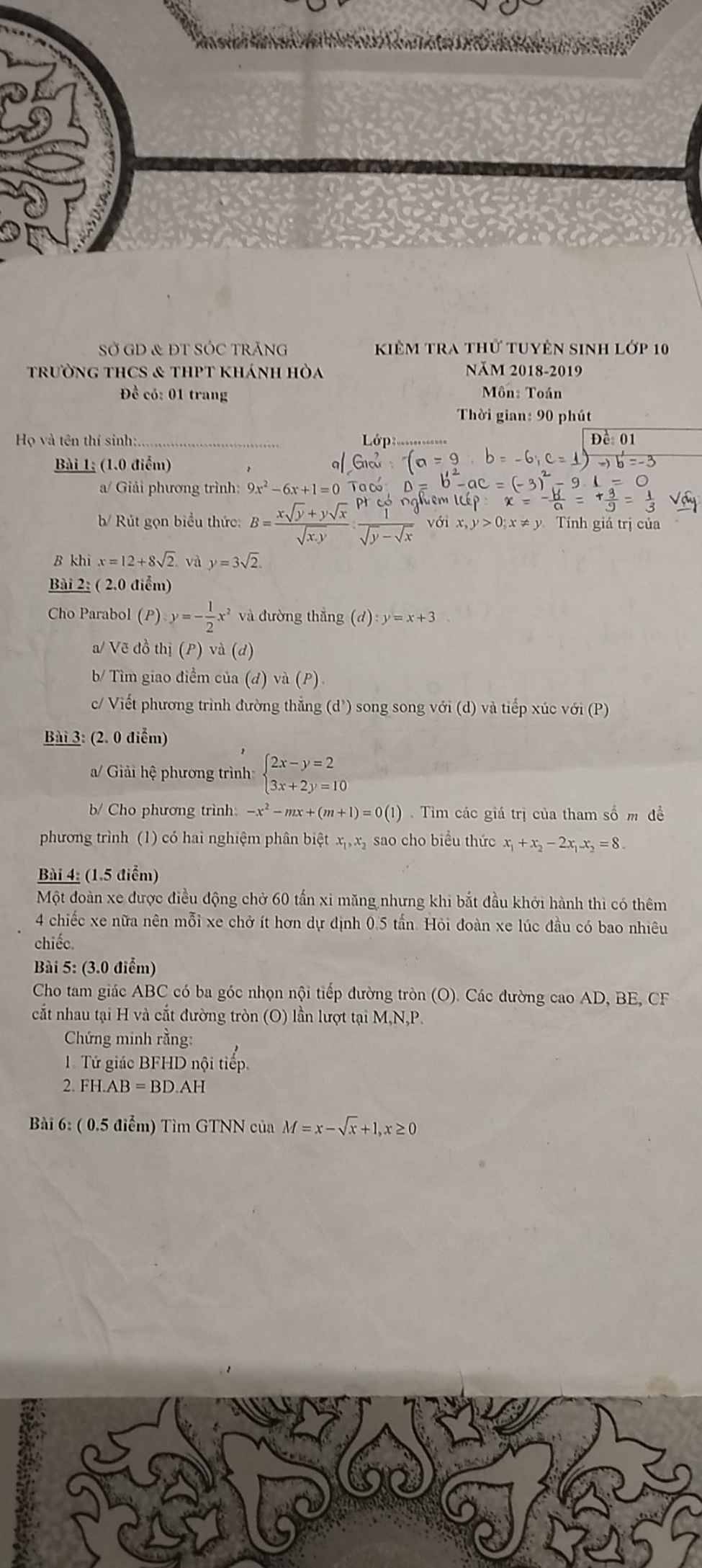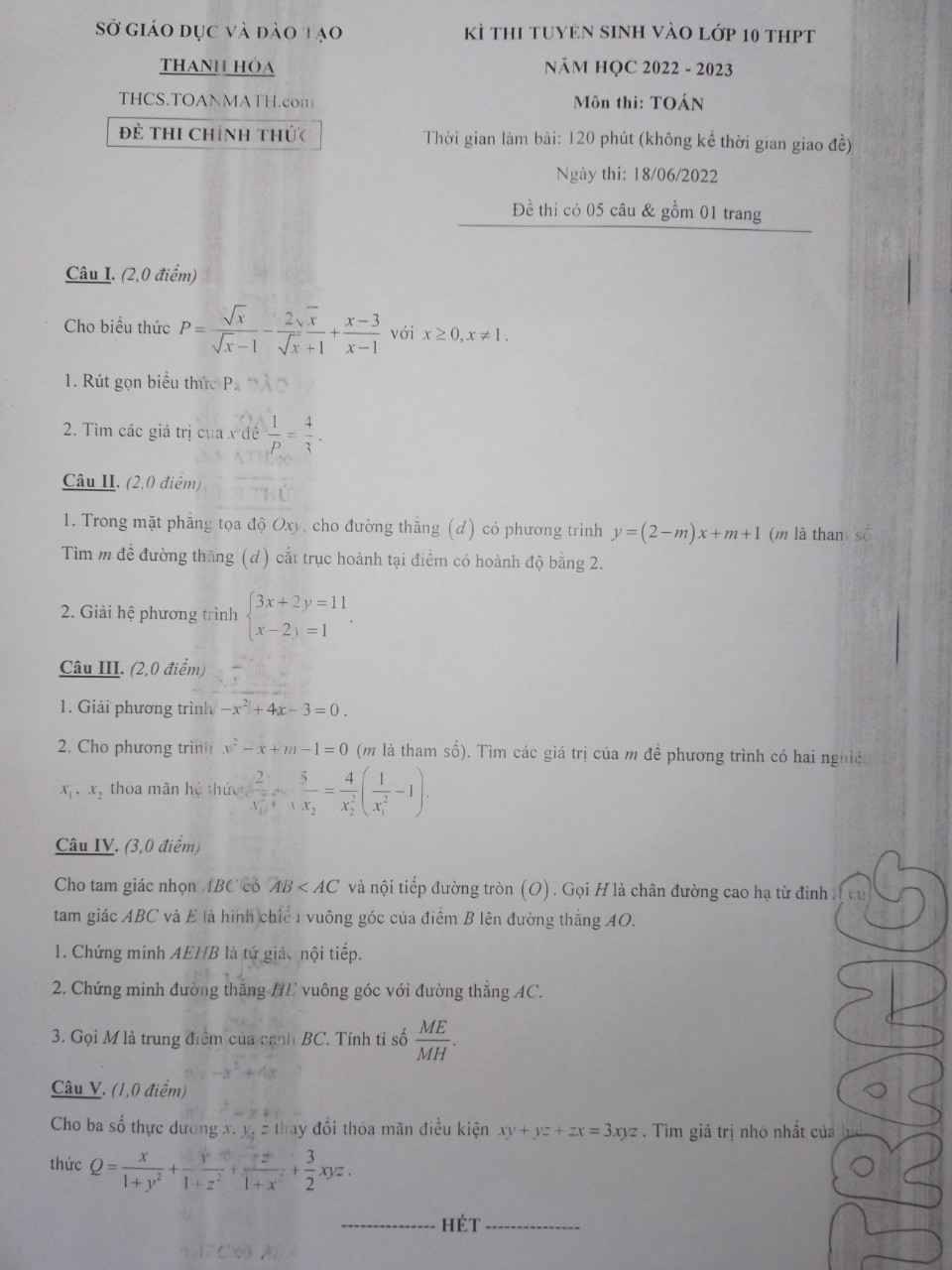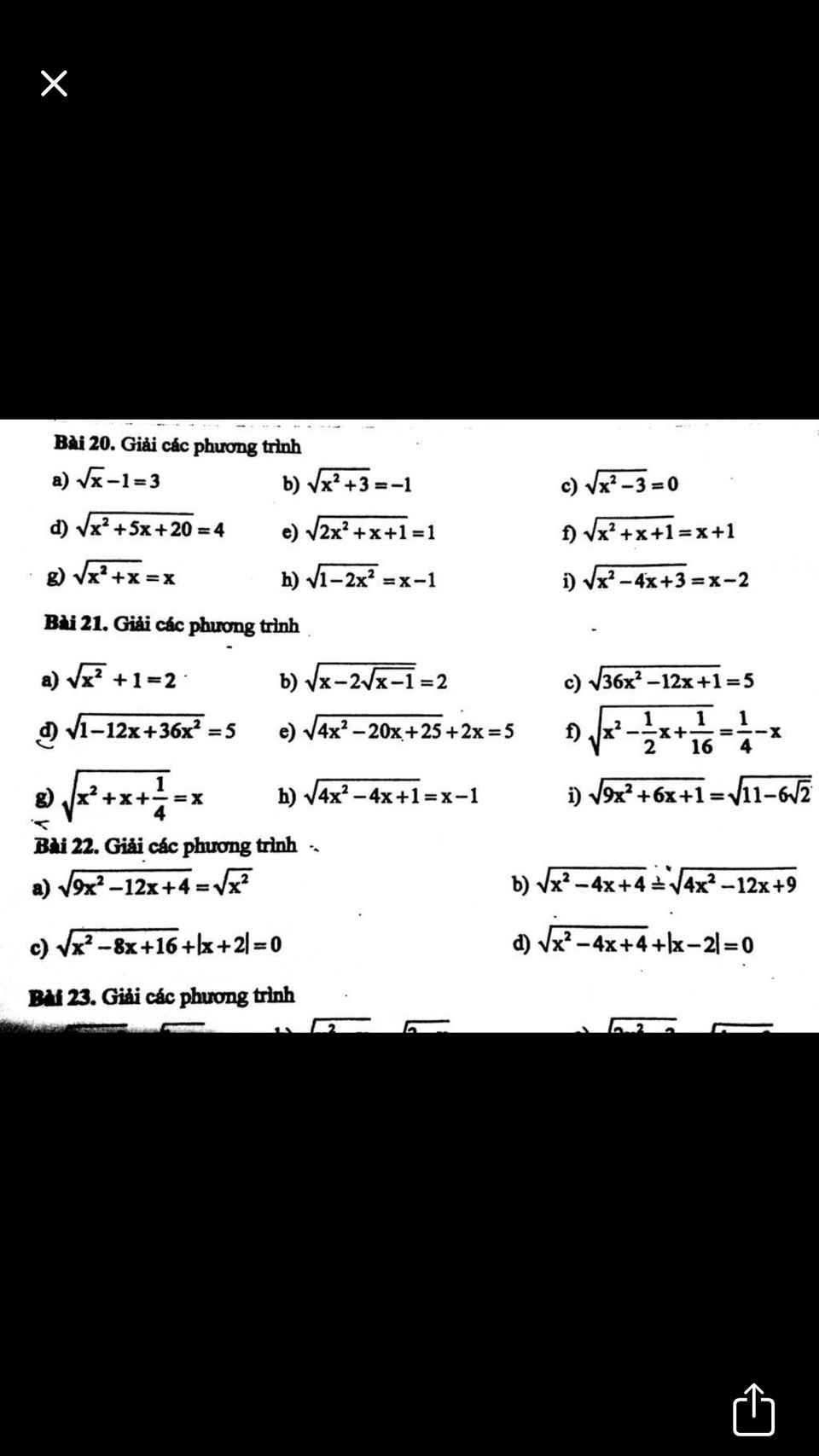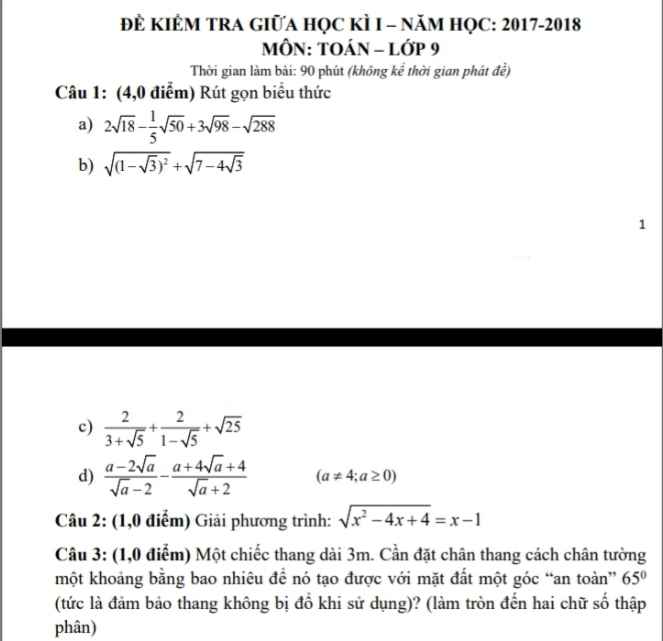
Hãy nhập câu hỏi của bạn vào đây, nếu là tài khoản VIP, bạn sẽ được ưu tiên trả lời.


Câu I:
1. \(P=\dfrac{\sqrt{x}}{\sqrt{x}-1}-\dfrac{2\sqrt{x}}{\sqrt{x}+1}+\dfrac{x-3}{x-1}\left(x\ge0;x\ne1\right)\)
\(=\dfrac{\sqrt{x}\left(\sqrt{x}+1\right)}{x-1}-\dfrac{2\sqrt{x}\left(\sqrt{x}-1\right)}{x-1}+\dfrac{x-3}{x-1}\)
\(=\dfrac{x+\sqrt{x}-2x+2\sqrt{x}+x-3}{x-1}\)
\(=\dfrac{3\sqrt{x}-3}{x-1}=\dfrac{3\left(\sqrt{x}-1\right)}{\left(\sqrt{x}+1\right)\left(\sqrt{x}-1\right)}=\dfrac{3}{\sqrt{x}+1}\)
2. \(\dfrac{1}{P}=\dfrac{4}{3}\)
\(\Leftrightarrow\dfrac{1}{\dfrac{3}{\sqrt{x}+1}}=\dfrac{4}{3}\)
\(\Leftrightarrow\dfrac{12}{\sqrt{x}+1}=3\)
\(\Leftrightarrow3\sqrt{x}+3=12\)
\(\Leftrightarrow\sqrt{x}=3\)
\(\Leftrightarrow x=9\left(Vì.x\ge0;x\ne1\right)\)
Câu II:
1. Vì đường thẳng (d) cắt trục hoành tại điểm có hoành độ bằng 2, nên đường thẳng (d) cắt trục hoành tại điểm có tọa độ (2;0)
Thay x = 2; y = 0 vào phương trình đường thẳng (d), ta được:
\(0=\left(2-m\right).2+m+1\)
\(\Leftrightarrow4-2m+m+1=0\)
\(\Leftrightarrow-m=-5\)
\(\Leftrightarrow m=5\)
Vậy nếu m = 5 thì đưởng thẳng (d) cắt trục hoành tại điểm có hoành độ bằng 2.
2. \(\left\{{}\begin{matrix}3x+2y=11\\x-2y=1\end{matrix}\right.\Leftrightarrow\left\{{}\begin{matrix}4x=12\\x-2y=1\end{matrix}\right.\Leftrightarrow\left\{{}\begin{matrix}x=3\\3-2y=1\end{matrix}\right.\Leftrightarrow\left\{{}\begin{matrix}x=3\\y=1\end{matrix}\right.\)
Vậy hệ phương trình có nghiệm duy nhất là (x; y) = (3; 1)


\(21,\\ e,PT\Leftrightarrow\left|2x-5\right|=5-2x\Leftrightarrow\left[{}\begin{matrix}2x-5=5-2x\left(x\ge\dfrac{5}{2}\right)\\5-2x=5-2x\left(x< \dfrac{5}{2}\right)\end{matrix}\right.\Leftrightarrow\left[{}\begin{matrix}x=\dfrac{5}{2}\left(tm\right)\\0x=0\left(tm\right)\end{matrix}\right.\\ \Leftrightarrow x\in R\\ f,\Leftrightarrow\left|x-\dfrac{1}{4}\right|=\dfrac{1}{4}-x\Leftrightarrow\left[{}\begin{matrix}x-\dfrac{1}{4}=\dfrac{1}{4}-x\left(x\ge\dfrac{1}{4}\right)\\\dfrac{1}{4}-x=\dfrac{1}{4}-x\left(x< \dfrac{1}{4}\right)\end{matrix}\right.\Leftrightarrow\left[{}\begin{matrix}x=\dfrac{1}{4}\left(tm\right)\\0x=0\left(tm\right)\end{matrix}\right.\\ \Leftrightarrow x\in R\)

\(\left(3\sqrt{7}\right)^2=63>28=\left(\sqrt{28}\right)^2\) hoặc \(3\sqrt{7}>2\sqrt{7}=\sqrt{28}\)


Câu 2:
Ta có: \(\sqrt{x^2-4x+4}=x-1\)
\(\Leftrightarrow2-x=x-1\left(x< 2\right)\)
\(\Leftrightarrow-2x=-3\)
hay \(x=\dfrac{3}{2}\left(tm\right)\)

Câu 1:
\(\Leftrightarrow\left\{{}\begin{matrix}a=2\\b\ne-3\\\dfrac{1}{2}a+b=\dfrac{5}{2}\end{matrix}\right.\Leftrightarrow\left\{{}\begin{matrix}a=2\\b=\dfrac{5}{2}-1=\dfrac{3}{2}\end{matrix}\right.\\ \Leftrightarrow y=2x+\dfrac{3}{2}\)

5.1) Gọi \(A\left(x_A;y_A\right)\) là giao điểm của \(\left(d_1\right)\) và \(\left(d_2\right)\)
\(\Rightarrow\left\{{}\begin{matrix}y_A=2x_A+1\\y_A=-x_A+3\end{matrix}\right.\Rightarrow2x_A+1=-x_A+3\Rightarrow3x_A=2\Rightarrow x_A=\dfrac{2}{3}\)
\(\Rightarrow y_A=\dfrac{7}{3}\Rightarrow A\left(\dfrac{2}{3};\dfrac{7}{3}\right)\)
2) Vì \(\left(d_3\right)\) đi qua A nên \(\dfrac{7}{3}=\dfrac{2}{3}\left(m-1\right)+3m-2\Rightarrow\dfrac{7}{3}=\dfrac{11}{3}m-\dfrac{8}{3}\)
\(\Rightarrow\dfrac{11}{3}m=5\Rightarrow m=\dfrac{15}{11}\)
3) Gọi \(B\left(x_B;y_B\right)\) là giao điểm của \(\left(d_1\right)\) và \(\left(d_3\right)\)
Vì \(B\in Ox\Rightarrow y_B=0\)
Vì \(B\in\left(d_1\right)\Rightarrow y_B=2x_B+1\Rightarrow0=2x_B+1\Rightarrow x_B=-\dfrac{1}{2}\)
\(\Rightarrow B\left(-\dfrac{1}{2};0\right)\Rightarrow0=-\dfrac{1}{2}\left(m-1\right)+3m-2\Rightarrow0=\dfrac{5}{2}m-\dfrac{3}{2}\)
\(\Rightarrow\dfrac{5}{2}m=\dfrac{3}{2}\Rightarrow m=\dfrac{3}{5}\)
c) Gọi \(C\left(x_C;y_C\right)\) là giao điểm của \(\left(d_2\right)\) và \(\left(d_3\right)\)
Vì \(C\in Oy\Rightarrow x_C=0\)
Vì \(B\in\left(d_2\right)\Rightarrow y_B=-x_B+3\Rightarrow y_B=3\Rightarrow C\left(0;3\right)\)
\(\Rightarrow3=3m-2\Rightarrow3m=5\Rightarrow m=\dfrac{5}{3}\)
 giúp e bài 3b và bài 6 vs ạ
giúp e bài 3b và bài 6 vs ạ







3b.
\(\Delta=m^2+4\left(m+1\right)=\left(m+2\right)^2\)
Pt có 2 nghiệm pb khi \(\left(m+2\right)^2>0\Rightarrow m\ne-2\)
Khi đó theo hệ thức Viet: \(\left\{{}\begin{matrix}x_1+x_2=-m\\x_1x_2=-\left(m+1\right)\end{matrix}\right.\)
\(x_1+x_2-2x_1x_2=8\)
\(\Leftrightarrow-m+2\left(m+1\right)=8\)
\(\Rightarrow m=6\) (thỏa mãn)
6.
\(M=x-\sqrt{x}+1=\left(x-\sqrt{x}+\dfrac{1}{4}\right)+\dfrac{3}{4}=\left(\sqrt{x}-\dfrac{1}{2}\right)^2+\dfrac{3}{4}\ge\dfrac{3}{4}\)
\(M_{min}=\dfrac{3}{4}\) khi \(\sqrt{x}=\dfrac{1}{2}\Rightarrow x=\dfrac{1}{4}\)
Cảm ơn nhiều ạ